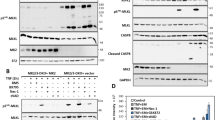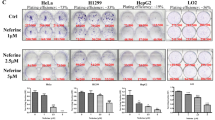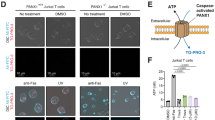Abstract
We have previously shown that low extracellular pH (pHe) promotes cell killing by the tumor necrosis factor-related apoptosis-inducing ligand (TRAIL). In this study, we examined whether amiloride, an inhibitor of the Na+/H+ antiporter capable of lowering the intracellular pH (pHi), can potentiate TRAIL-induced apoptotic death. Human prostate adenocarcinoma DU-145 cells were treated with various concentrations of TRAIL (10–200 ng/ml) and/or amiloride (0.1–1 mM) for 4 h. Amiloride, which caused little or no cytotoxicity by itself, enhanced TRAIL-induced apoptosis. The TRAIL-mediated activation of caspase, and PARP (poly (ADP-ribose) polymerase) cleavage were both promoted by amiloride. Western blot analysis showed that combined treatment with TRAIL and amiloride did not change the levels of TRAIL receptors (death receptor (DR)4, DR5, and DcR2 (decoy recepter 2) or antiapoptotic proteins (FLICE-inhibitory protein (FLIP), inhibitor of apoptosis (IAP), and Bcl-2). However, unlike pHe, amiloride promoted the dephosphorylation of Akt. Interestingly, amiloride also induced the dephosphorylation of P13K (phosphatidylinositol 3-kinase) and PDK-1 (phosphoinositide-dependent kinase-1) kinases along with PTEN (phosphatase and tensin homolog deleted on chromosome 10) and PP1α phosphatases. In vitro kinase assays revealed that amiloride inhibited phosphorylation of kinases and phosphatases by competing with ATP. Taken together, the present studies suggest that amiloride enhances TRAIL-induced cytotoxicity by inhibiting phosphorylation of the PI3K-Akt pathway-associated kinases and phosphatases.
This is a preview of subscription content, access via your institution
Access options
Subscribe to this journal
Receive 50 print issues and online access
$259.00 per year
only $5.18 per issue
Buy this article
- Purchase on Springer Link
- Instant access to full article PDF
Prices may be subject to local taxes which are calculated during checkout












Similar content being viewed by others
Abbreviations
- DcR1:
-
decoy receptor 1
- DcR2:
-
decoy receptor 2
- DR4:
-
death receptor 4
- DR5:
-
death receptor 5
- DTT:
-
dithiothreitol
- FADD:
-
Fas-associated death domain
- FasL:
-
Fas ligand
- FLICE:
-
Fas-associated death domain-like interleukin-1β-converting enzyme
- FLIP:
-
FLICE inhibitory protein
- IAP:
-
inhibitor of apoptosis
- PAGE:
-
polyacrylamide gel electrophoresis
- PARP:
-
poly (ADP-ribose) polymerase
- PBS:
-
phosphate-buffered saline
- PDK-1:
-
phosphoinositide-dependent kinase-1
- PI3K:
-
phosphatidylinositol 3-kinase
- PP1:
-
protein phosphatase 1
- PTEN:
-
phosphatase and tensin homolog deleted on chromosome 10
- SDS:
-
sodium dodecy1 sulfate
- TNF:
-
tumor necrosis factor
- TRAIL:
-
tumor necrosis factor-related apoptosis-inducing ligand
- DIDS:
-
4,4′-diisothiocyanatostilbene-2,2′-disulfonic acid
- amiloride:
-
3,5-diamino-6-chloro-N-(diaminomethylene)pyrazinecarboximide
References
Alessi DR, Andjelkovic M, Caudwell B, Cron P, Morrice N, Cohen P and Hemmings BA . (1996). EMBO J., 15, 6541–6551.
Anderson KE, Coadwell J, Stephens LR and Hawkins PT . (1998). Curr. Biol., 8, 684–691.
Andjelkovic M, Alessi DR, Meier R, Fernandez A, Lamb NJ, Frech M, Cron P, Cohen P, Cohen P, Lucocq JM and Hemmings BA . (1997). J. Biol. Chem., 272, 31515–31524.
Ashkenazi A and Dixit VM . (1999). Apoptosis control by death and decoy receptors. Curr. Opin. Cell. Biol., 11, 255–260.
Barriere H, Poujeol C, Tauc M, Blasi JM, Counillon L and Poujeol P . (2001). Am. J. Physiol. Cell. Physiol., 281, C810–C824.
Brunet A, Bonni A, Zigmond MJ, Lin MZ, Juo P, Hu LS, Anderson MJ, Arden KC, Blenis J and Greenberg ME . (1999). Cell, 96, 857–868.
Burow ME, Weldon CB, Tang Y, Navar GL, Krajewski S, Reed JC, Hammond TG, Clejan S and Beckman BS . (1998). Cancer Res., 58, 4940–4946.
Cardone MH, Roy N, Stennicke HR, Salvesen GS, Franke TF, Stanbridge E, Frisch S and Reed JC . (1998). Science, 282, 1318–1321.
Chen X, Thakkar H, Tyan F, Gim S, Robinson H, Lee C, Pandey SK, Nwokorie C, Onwudiwe N and Srivastava RK . (2001). Oncogene, 20, 6073–6083.
Chinnaiyan AM, Prasad U, Shankar S, Hamstra DA, Shanaiah M, Chenevert TL, Ross BD and Rehemtulla A . (2000). Proc. Natl. Acad. Sci. USA, 97, 1754–1759.
Cross DA, Alessi DR, Cohen P, Andjelkovich M and Hemmings BA . (1995). Nature, 378, 785–789.
Das S, Dixon JE and Cho W . (2003). Proc. Natl. Acad. Sci. USA, 100, 7491–7496.
Datta SR, Dudek H, Tao X, Masters S, Fu H, Gotoh Y and Greenberg ME . (1997). Cell, 91, 231–241.
Davis RJ and Czech MP . (1985). J. Biol. Chem., 260, 2543–2551.
Degli-Esposti MA, Dougall WC, Smolak PJ, Waugh JY, Smith CA and Goodwin RG . (1997a). Immunity, 7, 813–820.
Degli-Esposti MA, Smolak PJ, Walczak H, Waugh J, Huang CP, DuBose RF, Goodwin RG and Smith CA . (1997b). J. Exp. Med., 186, 1165–1170.
del Peso L, Gonzalez-Garcia M, Page C, Herrera R and Nunez G . (1997). Science, 278, 687–689.
Deveraux QL and Reed JC . (1999). Genes Dev., 13, 239–252.
Du K and Montminy M . (1998). J. Biol. Chem., 273, 32377–32379.
Endrich B, Hammersen F, Goetz A and Messmer K . (1982). J. Natl. Cancer Inst., 68, 475–485.
Frelin C, Vigne P, Ladoux A and Lazdunski M . (1988). Eur. J. Biochem., 174, 3–14.
Goldberg J, Huang HB, Kwon YG, Greengard P, Nairn AC and Kuriyan J . (1995). Nature, 376, 745–753.
Griffith TS, Chin WA, Jackson GC, Lynch DH and Kubin MZ . (1998). J. Immunol., 161, 2833–2840.
Gura T . (1997). Science, 277, 768.
Hetman M, Cavanaugh JE, Kimeiman D and Xia Z . (2000). J. Neurosci., 20, 2567–2574.
Hitoshi Y, Lorens J, Kitada SI, Fisher J, LaBarge M, Ring HZ, Francke U, Reed JC, Kinoshita S and Nolan GP . (1998). Immunity, 8, 461–471.
Holland R, Woodgett JR and Hardie DG . (1983). FEBS Lett., 154, 269–273.
Kandasamy K and Srivastava RK . (2002). Cancer Res., 62, 4929–4937.
Kashii Y, Uchida M, Kirito K, Tanaka M, Nishijima K, Toshima M, Ando T, Koizumi K, Endoh T, Sawada K, Momoi M, Miura Y, Ozawa K and Komatsu N . (2000). Blood, 96, 941–949.
Keane MM, Ettenberg SA, Nau MM, Russell EK and Lipkowitz S . (1999). Cancer Res., 59, 734–741.
Kennedy SG, Wagner AJ, Conzen SD, Jordan J, Bellacosa A, Tsichlis PN and Hay N . (1997). Genes Dev., 11, 701–713.
Kothny-Wilkes G, Kulms D, Luger TA, Kubin M and Schwarz T . (1999). J. Biol. Chem., 274, 28916–28921.
Laemmli UK . (1970). Nature, 227, 680–685.
Lee YJ, Song JJ, Kim JH, Kim HRC and Song YK . (2004). Exp. Cell. Res., 293, 129–143.
Maehama T and Dixon JE . (1998). J. Biol. Chem., 273, 13375–13378.
Marsters SA, Sheridan JP, Pitti RM, Huang A, Skubatch M, Baldwin D, Yuan J, Gurney A, Goddard AD, Godowski P and Ashkenazi A . (1997). Curr. Biol., 7, 1003–1006.
Martelli AM, Tazzari PL, Tabellini G, Bortul R, Billi AM, Manzoli L, Ruggeri A, Conte R and Coco L . (2003). Leukemia, 17, 1794–1805.
Myers MP, Solaria JP, Eng C, Li J, Wang SI, Wiggler MH, Parsons R and Tonks NK . (1997). Proc. Natl. Acad. Sci. USA, 94, 9052–9057.
Nagane M, Pan G, Weddle JJ, Dixit VM, Cavenee WK and Huang HJ . (2000). Cancer Res., 60, 847–853.
Nam SY, Amoscato AA and Lee YJ . (2002). Oncogene, 21, 337–346.
Nesterov A, Lu X, Johnson M, Miller GJ, Ivashchenko Y and Kraft AS . (2001). J. Biol. Chem., 276, 10767–10774.
Ozes ON, Mayo LD, Gustin JA, Pfeffer SR, Pfeffer LM and Donner DB . (1999). Nature, 401, 82–85.
Pan G, Ni J, Wei YF, Yu G, Gentz R and Dixit VM . (1997a). Science, 277, 815–818.
Pan G, O′Rourke K, Chinnaiyan AM, Gentz R, Ebner R, Ni J and Dixit VM . (1997b). Science, 276, 111–113.
Panka DJ, Mano T, Suhara T, Walsh K and Mier J . (2001). J. Biol. Chem., 276, 6893–6896.
Pitti RM, Marsters SA, Ruppert S, Donahue CJ, Moore A and Ashkenazi A . (1996). J. Biol. Chem., 271, 12687–12690.
Ralph RK, Smart J, Wojcik SJ and McQuillan J . (1982). Biochem. Biophys. Res. Commun., 104, 1054–1059.
Rameh LE and Cantley LC . (1999). J. Biol. Chem., 274, 8347–8350.
Resjo S, Goransson O, Harndahl L, Zolnierowicz S, Manganiello V and Degerman E . (2002). Cell Signal., 14, 231–238.
Rodriguez-Viciana P, Warne PH, Vanhaesebroeck B, Waterfield MD and Downward J . (1996). EMBO J., 15, 2442–2451.
Romashkova JA and Makarov SS . (1999). Nature, 401, 86–90.
Sato T, Irie S, Kitada S and Reed JC . (1995). Science, 268, 411–415.
Sheikh MS, Burns TF, Huang Y, Wu GS, Amundson S, Brooks KS, Fornace Jr AJ and el-Deiry WS . (1998). Cancer Res., 58, 1593–1598.
Sheridan JP, Marsters SA, Pitti RM, Gurney A, Skubatch M, Baldwin D, Ramakrishnan L, Gray CL, Baker K, Wood WI, Goddard AD, Godowski P and Ashkenazi A . (1997). Science, 277, 818–821.
Smith RL, Macara IG, Levenson R, Housman D and Cantley L . (1982). J. Biol. Chem., 257, 773–780.
Soltoff SP and Mandel LJ . (1983). Science, 220, 957–959.
Staal SP . (1987). Proc. Natl. Acad. Sci USA, 84, 5034–5037.
Tamm I, Wang Y, Sausville E, Scudiero DA, Vigna N, Oltersdorf T and Reed JC . (1998). Cancer Res., 58, 5315–5320.
Thakkar H, Chen X, Tyan F, Gim S, Robinson H, Lee C, Pandey SK, Nwokorie C, Onwudiwe N and Srivastava RK . (2001). J. Biol. Chem., 276, 38361–38369.
Torres J and Pulido R . (2001). J. Biol. Chem., 276, 993–998.
Tschopp J, Martinon F and Hofmann K . (1999). Curr. Biol., 9, R381–R384.
Vassilev A, Ozer Z, Navara C, Mahajan S and Uckun FM . (1999). J. Biol. Chem., 274, 1646–1656.
Walczak H, Degli-Esposti MA, Johnson RS, Smolak PJ, Waugh JY, Boiani N, Timour MS, Gerhart MJ, Schooley KA, Smith CA, Goodwin RG, Rauch and Rauch CT . (1997). EMBO J., 16, 5386–5397.
Wen J, Ramadevi N, Nguyen D, Perkins C, Worthington E and Bhalla K . (2000). Blood, 96, 3900–3906.
Wike-Hooley JL, Haveman J and Reinhold HS . (1984). Radiother Oncol., 2, 343–366.
Wu KL, Khan S, Lakhe-Reddy S, Jarad G, Mukherjee A, Obejero-Paz CA, Konieczkowski M, Sedor JR and Schelling JR . (2004). J. Biol. Chem., 279, 26280–26286.
Xu W, Yuan X, Jung YJ, Yang Y, Basso A, Rosen N, Chung EJ, Trepel J and Neckers L . (2003). Cancer Res., 63, 7777–7784.
Acknowledgements
This work was supported by the following grants: NCI Grants CA48000, CA95191, and CA96989, Competitive Medical Research Fund of University of Pittsburgh Medical Center Health System, Oral Cancer Center Grant Fund, Elsa U Pardee Foundation, The Pittsburgh Foundation, Department of Defense Prostate Cancer Research Program Fund (PC020530), and Department of Defense Prostate Cancer Traineeship (PC040833).
Author information
Authors and Affiliations
Corresponding author
Rights and permissions
About this article
Cite this article
Kim, K., Lee, Y. Amiloride augments TRAIL-induced apoptotic death by inhibiting phosphorylation of kinases and phosphatases associated with the P13K-Akt pathway. Oncogene 24, 355–366 (2005). https://doi.org/10.1038/sj.onc.1208213
Received:
Revised:
Accepted:
Published:
Issue Date:
DOI: https://doi.org/10.1038/sj.onc.1208213
Keywords
This article is cited by
-
Amiloride ameliorates muscle wasting in cancer cachexia through inhibiting tumor-derived exosome release
Skeletal Muscle (2021)
-
Amiloride sensitizes human pancreatic cancer cells to erlotinib in vitro through inhibition of the PI3K/AKT signaling pathway
Acta Pharmacologica Sinica (2015)
-
A monoclonal antibody (Mc178-Ab) targeted to the ecto-ATP synthase β-subunit-induced cell apoptosis via a mechanism involving the MAKase and Akt pathways
Clinical and Experimental Medicine (2012)
-
α-Tocopheryl succinate induces apoptosis in erbB2-expressing breast cancer cell via NF-κB pathway
Acta Pharmacologica Sinica (2010)
-
The TRAIL apoptotic pathway in cancer onset, progression and therapy
Nature Reviews Cancer (2008)



